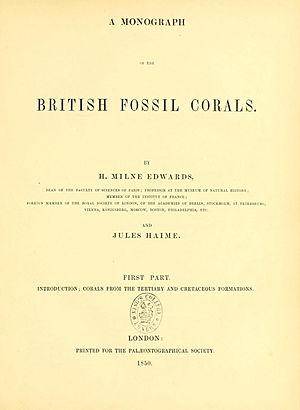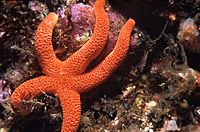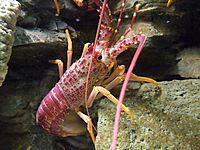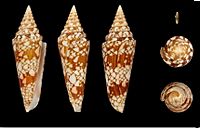Henri Milne-Edwards facts for kids
Quick facts for kids
Henri Milne-Edwards
|
|
|---|---|
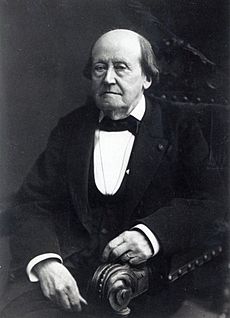 |
|
| Born | 23 October 1800 |
| Died | 29 July 1885 (aged 84) Paris, French Third Republic
|
| Nationality | French |
| Alma mater | University of Paris |
| Awards | Copley Medal (1856) |
| Scientific career | |
| Fields | Zoology |
| Author abbrev. (zoology) | Milne-Edwards |
Henri Milne-Edwards (born October 23, 1800 – died July 29, 1885) was a famous French scientist. He was a zoologist, which means he studied animals and their lives. He made many important discoveries about different animal groups, especially sea creatures.
Contents
About Henri Milne-Edwards
Henri Milne-Edwards was born in Bruges, which is now part of Belgium. At the time, Bruges was part of the new French Republic. He was the 27th child of William Edwards, who was an English planter, and Elisabeth Vaux, a Frenchwoman.
Henri spent most of his life in France. His older brother, Guillaume Frederic Edwards, helped raise him in Paris. Guillaume was also a well-known scientist who studied the human body and different cultures.
Henri first studied medicine and became a doctor in Paris in 1823. But he loved natural history even more. So, he decided to focus on studying animals, especially smaller creatures. He learned from a famous scientist named Georges Cuvier. He also became good friends with another scientist, Jean Victoire Audouin.
Henri married Laura Trézel, and they had nine children. One of his sons, Alphonse Milne-Edwards, also became a famous biologist.
His Name
Henri's original first name was Milne. To avoid confusion with his many relatives, he added it to his last name, Edwards. He usually wrote his name as "Milne Edwards." His son, Alphonse, always used "Milne-Edwards" with a hyphen. When scientists talk about animals named by either father or son, they often use "Milne-Edwards."
Henri's Scientific Work
Henri Milne-Edwards was very active in science. One of his first important papers was about crustaceans, which are animals like crabs and lobsters. He presented this paper in 1829. It was based on two trips he took with his friend Audouin to explore the sea near Granville, France. They used special tools to collect sea animals from the ocean floor.
Their research showed that the sea animals along that part of the French coast lived in four different zones. This was a new and important idea for understanding marine life.
In 1829, he also studied reptiles. He described and named five new types of lizards.
Henri became a professor in 1832, teaching about health and natural history. Later, in 1841, he took over a special position at the Muséum National d'Histoire Naturelle in Paris, where he taught about insects. In 1862, he became the head of zoology there.
Much of his new research was published in a science magazine called Annales des sciences naturelles. He also helped edit this magazine starting in 1834.
He wrote several important books:
- Histoire naturelle des Crustacés (Natural History of Crustaceans), published from 1837 to 1841. This book was a key resource for many years.
- Histoire naturelle des coralliaires (Natural History of Corals), published from 1858 to 1860.
- Leçons sur la physiologie et l'anatomie comparée de l'homme et des animaux (Lessons on the Physiology and Comparative Anatomy of Man and Animals). This was a huge work with 14 volumes!
- A smaller book about the basics of zoology, first published in 1834. It was updated many times and was very popular.
In 1842, Henri was chosen as a foreign member of the Royal Society in London. This is a very respected science group. In 1856, the Royal Society gave him the Copley Medal. This award recognized all his amazing work in zoology. He passed away in Paris in 1885.
His son, Alphonse Milne-Edwards, also became a famous scientist. He studied fossil birds and explored the deep sea.
Animals Named After Henri Milne-Edwards
Henri Milne-Edwards
Many animals and groups of animals have been named in honor of Henri Milne-Edwards. This is a way for other scientists to remember his important contributions to zoology. Here are some examples:
- Edwardsia de Quatrefages, 1841
- Edwardsiella Andres, 1883
- Henricia J. E. Gray, 1840
- Myrianida edwardsi (de Saint-Joseph, 1887)
- Lophoura edwardsi Kölliker, 1853
- Aristaeopsis edwardsiana (Johnson, 1868)
- Plesionika edwardsii (Brandt, 1851)
- Dynamene edwardsi (Lucas, 1849)
- Grapsicepon edwardsi Giard & Bonnier, 1888
- Glossocephalus milneedwardsi Bovallius, 1887
- Onisimus edwardsii (Krøyer, 1846)
- Diastylis edwardsi (Krøyer, 1841)
- Neoamphitrite edwardsii (de Quatrefages, 1865)
- Colpaster edwardsi (Perrier, 1882)
- Milnesium Doyère, 1840
- Jasus edwardsii (Hutton, 1875)
- Odontozona edwardsi (Bouvier, 1908)
- Milneedwardsia Bourguignat, 1877
- Boeckosimus edwardsii (Krøyer, 1846)
- Lithophyllon edwardsi (Rosseau, 1850)
- Goniastria edwardsi Chevalier, 1971
- Fedora edwardsi Jullien, 1882
- Ciona edwardsi (Roule, 1886)
- Maasella edwardsi (de Lacaze-Duthiers, 1888)
- Forskalia edwardsi Kölliker, 1853
- Costa edwardsii (Roemer, 1838)
- Colobomatus edwardsi (Richiardi, 1876)
- Salmincola edwardsi (Olsson, 1869)
- Aristaeopsis edwardsianus (Johnson, 1867)
- Sergestes edwardsii Krøyer, 1855
- Odontozona edwardsi (Bouvier, 1908)
- Alphaeus edwardsii (Audouin, 1826)
- Ebalia edwardsii Costa, 1838
- Fedora edwardsi Jullien, 1882
- Teuchopora edwardsi (Jullien, 1882)
- Calliostoma milneedwardsi Locard, 1898
- Ocinebrina edwardsii Payraudeau, 1826
- Discodoris edwardsi Vayssière, 1902
- Tergipes edwardsii Nordmann, 1844
- Sadayoshia edwardsii (Miers, 1884)
- Periclimenes edwardsi (Paulson, 1875)
- Ocenebra edwardsi Payraudeau, 1826
- Conus milneedwardsi F. P. Jousseaume, 1894
- Montipora edwardsi Bernard, 1879
- Goniastrea edwardsi Chevalier, 1971
- Pagurus edwardsi (Dana, 1852)
- Chirostylus milneedwardsi (Henderson, 1885)
- Pisoides edwardsi Bell, 1835
- Cancer edwardsi Bell, 1835
- Diogenes edwardsii (de Haan, 1849)
- Propithecus edwardsi (A. Grandidier, 1871)
- Archaeoniscus edwardsii (Westwood, 1854)


